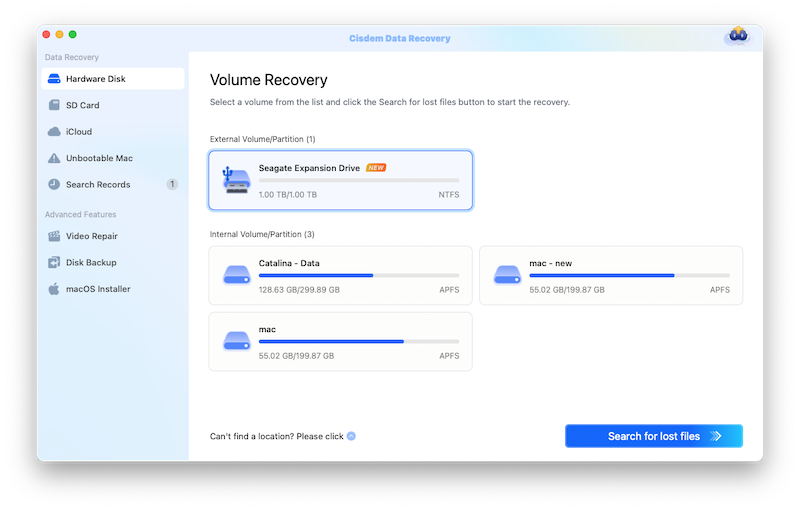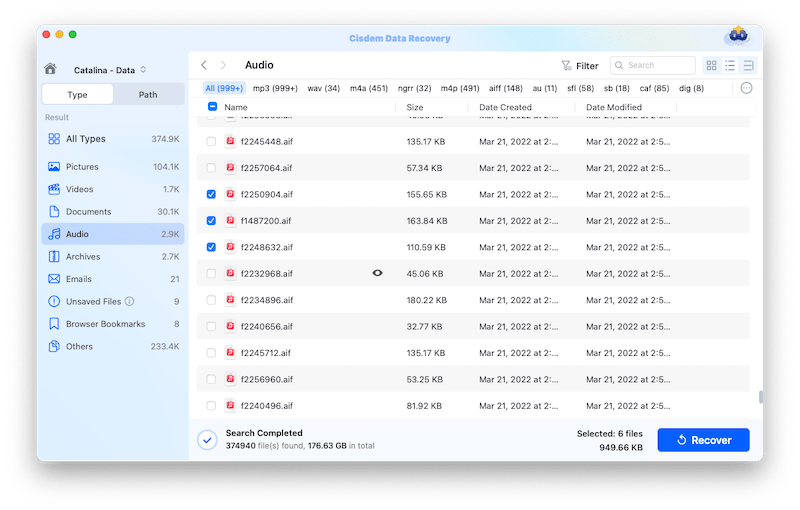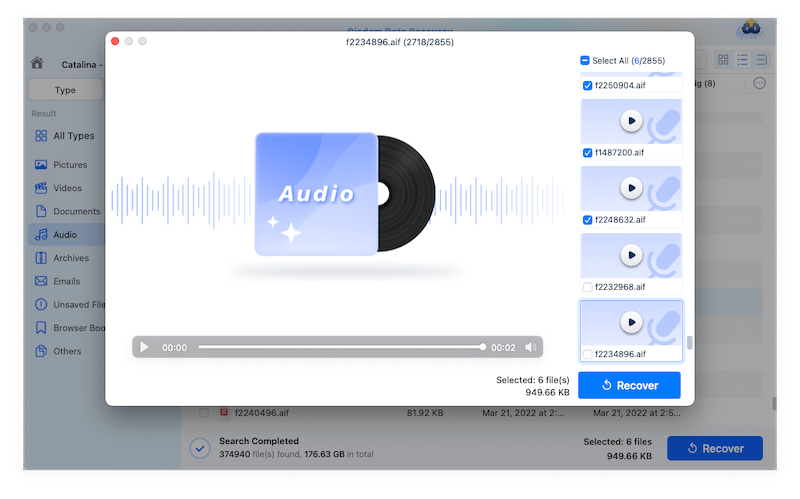Fix Mac Volume not Working in FREE Simple Ways
 339
339
 0
0
Anyone knows why I can’t control the volume? On top of that my right speaker just decided to stop working out of the blue. So what’s up and how can I solve this? It’s a 13 inch m1 MacBook Pro. --- Post from Reddit
Feel the same perplexed and unprepared as the above situation when realizing that you can’t control your Mac sound? This article must be your landing page. It’s a full troubleshooting guide on how to fix Mac volume not working issue both with internal and external speakers.
 Cisdem Data Recovery for Mac
Cisdem Data Recovery for Mac
Recover Audio Files Caused by Mac Volume Issues Easily
- Support the audio file recovery on macOS Ventura or earlier versions
- Scan system disk on M1, M2 and T2 devices
- Tackle any data loss situations, like mistaken deletion, macOS update, hardware failure, system crash, virus attack, human error or other unexpected cases
- High recovery rate with straightforward process
- Locate wanted audio files efficiently by filter tools incl. keyword, file size, date created and date modified
- Preview options before recovery
- Restore audio files to local drives on Mac or cloud platforms
Why is the Volume not Working on My Mac?
Why does my mac suddenly have no sound? There are a couple of potential reasons which could lead to volume on Mac not working and stuck on mute. To quickly identify and fix the problem in your condition, I’ll list some of the major ones.
- Incorrect output device is chosen.
- Foreign matters (dust, waste, etc.) exist in the audio port.
- Some peripherals plugged into Mac interfere with sound output.
- macOS operating system is not kept up to date.
- Mac machine didn’t boot up normally.
- Audio settings have been altered on Mac.
- The program you use to play sound is incompatible with the audio file format.
- Certain hardware components (speakers or headphones) are broken/damaged.
- Your Mac is equipped with corrupted sound firmwares or drivers.
In face of volume not working on Mac, whether you play sound with internal or external speakers, the first action you should take is confirming all the sound settings to be correct. By clicking the speaker icon at the top-right menu bar on your Mac screen, go to Sound Preferences > Output.
If you have an external speaker device, select “Headphones” for sound output. While if you are using internal speakers, set the sound output as built-in speakers. Besides, the output volume should not be turned down completely, and the checkbox next to “Mute” shouldn’t be ticked.
What if Mac Sound not Working on Internal Speakers?
Once you can’t hear any voice from Mac internal speakers, see the following 5 proven fixes. Hope at least one of them can suit your case.
Method 1: Check macOS Updates
macOS applications in old versions are likely to cause Mac volume not working. Here are the steps to update macOS programs to their latest versions.
- Click on Apple icon at the top left corner > choose “About This Mac”.
![uodate macos software 01]()
- Select “Software Update...”. macOS will begin to scan for available updates.
![uodate macos software 02]()
- If any software updates are listed, click “Update Now”. If the software updates have been already downloaded, click “Restart” to do the installation.
![uodate macos software 03]()
Method 2: Restart Sound Controller on Mac
Sound Controller plays a key role in playing your audio files on Mac. Sound Controller operating improperly can result in no volume on Mac. Now let’s try to restart the Sound Controller.
- Open Activity Monitor using Spotlight.
![restart sound controller 01]()
- Type “coreaudiod” in the search bar to search for Core Audio controller.
![restart sound controller 02]()
- Choose the controller > click X tab to quit it. Then the controller will restart automatically.
Method 3: Remove Mac Malware
Mac can also become silent when attacked by malwares or viruses. Here Activity Monitor is used again to check for malwares on Mac. Follow up the tutorial.
- Launch Activity Monitor.
- Go to CPU section if you’re not in it.
- Click the “% CPU” column to sort values from high to low > check for those high CPU uses.
![remove mac malware 01]()
- Suppose a process is considered to be suspicious, search it on Google to clarify whether it’s malware or not. If yes, eliminate it from your Mac.
![remove mac malware 02]()
Method 4: Fix Volume with Terminal
Terminal is another handy tool to fix technical problems on Mac like audio issues. To settle Mac volume not working and get the sound back, proceed with the instructions below in Terminal for resetting the core audio.
- Go to Finder > Applications > Utilities > Terminal. Double click to open it.
![reset core audio 01]()
- Type the command line: “sudo killall coreaudiod” in the input window> press Enter. Type your password if asked.
![reset core audio 02]()
- Now the coreaudiod process is terminated. Go for testing if volume works on Mac internal speakers now.
Method 5: Reset NVRAM/PRAM
Non-volatile random-access memory (NVRAM) or parameter RAM (PRAM) is responsible for controlling specific settings related to audio and sound. That’s why resetting NVRAM or PRAM might be useful when volume locked on your Mac. This is what you should do.
- Shut down your Mac.
- Restart it while holding Command + Option + P + R.
![reset nvram]()
- Release them when hearing a second startup chime or Apple logo appears & disappears again.
Zapping your NVRAM/PRAM will return your startup disk, time zone, and audio preferences to their default. In theory, this will also solve the volume not working on Mac issue.
What if Mac Volume not Working on External Speakers?
Instead of internal speaker devices built in Mac, assuming you get accustomed to using external speakers but find them malfunctioned someday, 4 fixes in this part will be dived in for your option.
Method 1: Ensure a Proper Connection
As external speakers not workable on Mac, the first point to be considered is whether Mac and speakers are in good connectivity. First keep your Mac audio port free of dust. In case the speaker or headphone jack shows a red light, it means that dust or waste is stranded inside the connection port. Use compressed air and toothpicks to clean it up gently. Also make sure that the connection cable is properly attached to the audio port. You are also allowed to unplug and replug the external speakers to adjust the connection.

Method 2: Try Other Speakers/Mac
Once the Mac volume not working issue continues after proper connection has been confirmed, try to connect your speakers into another piece of Mac or change the speakers on your Mac. So you can test whether the issue is with the speaker itself or the Mac sound output port.
Method 3: Check Bluetooth Settings
If one pair of Bluetooth earphones is used for playing sound, Mac volume not working could occur when the earphones fail to be paired to the computer. Make sure the Bluetooth is truly set to be turned on via System Preferences > Bluetooth.

Method 4: Test Speaker with Audio MIDI Setup
Audio MIDI Setup deals with things like Bluetooth audio, USB audio, virtual desktop audio, etc. To fix Mac volume not working issue with external speakers, checking the audio settings in it is also a feasible practice.
- Go to Finder > Applications > Utilities > Audio MIDI Setup.
![audio midi setup 01]()
- Pay attention to the small icons next to the audio devices. Now you can tell which devices are used for output, input and system sounds at current stage.
![audio midi setup 02]()
- Select the device you’d like to get volume from > right-click on it > choose “Use This Device For Sound Output”.
![audio midi setup 03]()
- Click Output button and make sure no channels under “Channel Volume” are muted.
![audio midi setup 04]()
- Your external speaker can be also tested through selecting “Configure Speakers” button. Click the speaker icon to play a hissing sound. If you hear it, it indicates that the speaker works well. Then the Mac audio not working problem must be resulted from somewhere else.
![audio midi setup 05]()
Unluckily, whatever internal or external speakers, provided that all the above methods can’t fix the Mac volume not working successfully, send your Mac to the nearest Apple service place for repair as the last resort.
Bonus Tip: How to Recover Audio Files Caused by Mac Volume Issues?
Mac volume not working disables audio file to be played. Similarly, other Mac volume issues also tend to make users delete or lost audio files by accident. To recover deleted or lost audio files on Mac, a specialized data recovery application is your top priority. Here I will take Cisdem Data Recovery for example.
With advanced computer algorithm and competitive price, Cisdem Data Recovery has risen in popularity on the Internet in the last few years. This premium tool helps to recover 200+ types of file (audios, videos, pictures, archives, emails, documents, raw files, etc.) from Mac-based devices like fusion drive, HDD, SSD, SD card, memory card and more without a hassle.
Here’s how to recover audio files on Mac using Cisdem Data Recovery.
- Free download, install and launch this program on your Mac.
 Free Download macOS 10.9 or later
Free Download macOS 10.9 or later - Scan a drive.
Go to Hardware Disk > choose the exact drive where your audio files were stored in > click “Search for lost files” button to start the scanning.![cisdem data recovery 01]()
- Specify the lost audio files.
After both quick scan and deep scan done, all recoverable items will be displayed based on different file categories. Select Type > Audio to find and preview the audio files you lost.![cisdem audio recovery 01]()
- Recover the audio files.
Select the wanted audio files > click “Recover” to restore them back.![cisdem audio recovery 02]()

Connie Yu has been a columnist in the field of data recovery since 2011. She studied a lot of data loss situations and tested repeatedly to find a feasible solution tailored for each case. And her solutions are always updated to fix problems from the newest systems, devices and apps.

JK Tam is the lead developer at Cisdem, bringing over two decades of hands-on experience in cross-platform software development to the editorial team. He is now the lead technical approver for all articles related to Data Recovery and DVD Burner.





















